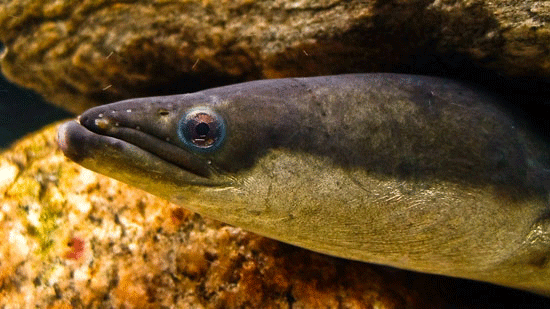The American Eel and the Norwalk River
The Story of the American Eel and the Norwalk River
The 4th and 5th graders in Wilton and Ridgefield know more about the life cycle of the American Eel than the adults in town. That is due to the fact that the 4th/5th grade science curriculum in these towns, known as the River Study Program, teaches our children about the very interesting, but not fully understood, life cycle of the American eel and what role the Norwalk River plays in that cycle.
The eel probably has the broadest diversity of habitats of any fish species in the world. Most migratory fish, such as salmon and shad, are anadromous, spawning in fresh water and living as adults in salt water. The eel is one of the few fishes that does the opposite, spawning in the ocean and spending its adulthood in freshwater lakes, rivers and estuaries. The American eel is native to the eastern United States. The American eel can be found all along the Atlantic coast from Greenland to northern South America, in major rivers, streams, and even in many land-locked lakes.
The American eel’s story begins and ends in the Sargasso Sea, a part of the Atlantic Ocean which features the infamous “Bermuda Triangle” located south-southeast of Bermuda and north of the Bahamas. The newly hatched eel larvae known as leptocephali spend their first year of their lives drifting on ocean currents that dictate their path toward the North American coast. The eels that find themselves in the Norwalk River were whisked there by the strong Gulf Stream. It is here that these transparent “leaf fish” undergo the first of four transformations and become “glass eels” that possess both male and female characteristics.
As the glass eel enters the Norwalk River, it undergoes another transformation and becomes pigmented, turning a murky yellowish-green, and begins to resemble the eels with which we are familiar. In this immature stage, the eel is now known as an “elver”. For reasons that scientists do not understand, some elvers remain in the estuary and become males, while others migrate upriver and become females.
Elvers grow into “yellow eels” that have thick, slimy skin that protects them from sharp rocks and keeps them from drying out as they go over land to bypass dams and search for their home waters. The Norwalk River has seven dams, including the Flock Process Dam that is close to 18 feet high. Despite their difficult journey up the Norwalk River, DEP fish surveys, both from 1990 and the 2000 timeframe, show that eels are present in very good numbers. There are, however, fewer eels further upriver than closer to the estuary, reflecting the strenuous nature of their trek.
Once at their destination, eels have a relatively small range. During the day, they burrow in bottom sediments and become active only at night, when they feed on small fish, insects, worms, crayfish, and snails. During winter, eels hibernate by burrowing into the bottom mud. This phase of the eel’s life cycle can last from 5 years for the males to about 20 years for the females. During this phase, females may reach two to five feet in length and weigh three to four pounds, while males will grow to be only about half the size of females. Land-locked eels, however, can reach five to six feet long and weigh ten to fifteen pounds.
The American eel’s final transformation occurs before they begin their long return journey back to the Sargasso Sea, where they were born, where they will breed, and where they will die. The change and migration usually occurs in the late summer and fall. Triggered by some unknown impetus, the eels begin heading downstream towards the sea, with the peak migration occurring from September to November. Physical changes accompany this fourth metamorphosis. The yellow eel turns to a blackish-bronze color, their eyes enlarge, they fatten, their sexual organs mature, they develop thicker skin and their digestive tract degenerates. They are now “silver eels”. Upon arrival in the Sargasso Sea, the female eel will lay over a million eggs and the male will fertilize them. Although no one has ever found their bodies, it is believed that the mature eels will then die!
The population of the American eel has been decreasing in an alarming manner since the 1970s, declining by as much as 99% in the last 25 years due to hydropower plants, over-fishing, parasites, and other unknown causes. In fact, the American eel has been considered for protection under the Endangered Species Act. American eels follow a complex life pattern involving several migrations and metamorphoses. It is this complex and specific life pattern that has made American eels particularly susceptible to both over-fishing and habitat destruction or obstruction, such as the construction of dams.
One of the best things we can do for eels is to allow unrestricted access to coastal watersheds and safe passage back to the sea. Thus, we need to focus on man-made migration barriers, especially dams and culverts.
Recommended further reading about the American eel: EELS: AN EXPLORATION, FROM NEW ZEALAND TO THE SARGASSO, OF THE WORLD’S MOST AMAZING AND MYSTERIOUS FISH by James Prosek


